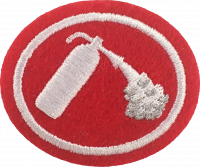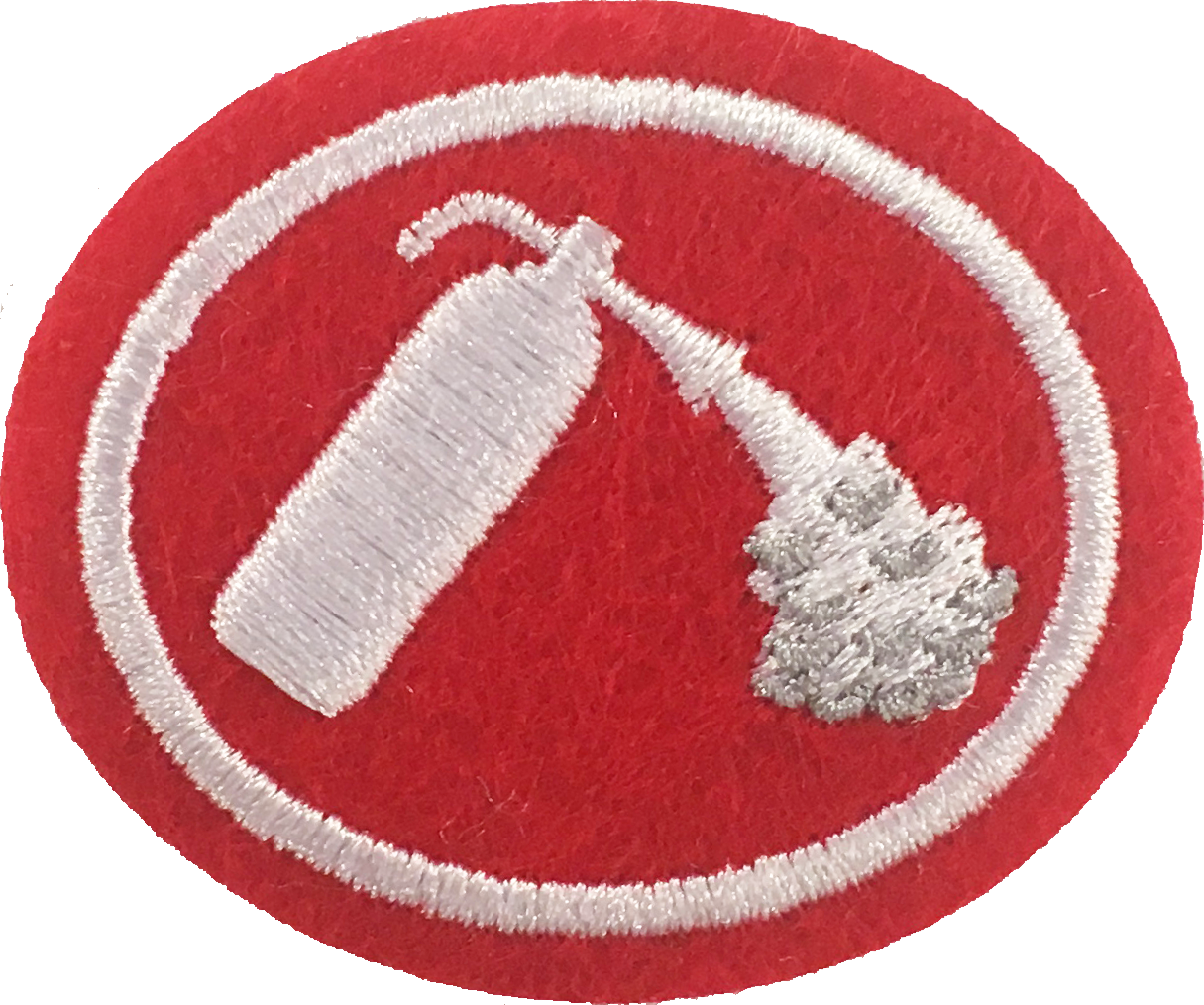AY Honors/Fire Safety/Answer Key
1
For tips and instruction see Red Alert.
2
Find a nearby fire station (which can be in the community, at an airport, or a Park/Forestry Service station) and arrange to have your group tour their facility or have someone come and speak to your group about what they do, how they do it, and maybe a story about an incident that could have been prevented. If you expect a fireman to teach any of the requirements for this honor, let them know ahead of time and give them the requirements.
3
Fire Drill
Work with your principal or superintendent on this requirement. They are often in charge of these activities and should already have a proper procedure. Ask to help them with one of the drills, explaining why. After the fire drill it would be a good idea to have them explain why they use the procedure that they used. Make maps for exit routes and post them throughout the school, if they are not already there. If they are already in place review them and have the principal or superintendent explain how they work.
What information should be put on the Exit map?
- Show primary route/routes using colored lines.
- Show secondary route/routes using a different color for the lines.
- Show locations of fire alarm pull stations.
- Show locations of fire extinguishers.
- Make a map of each floor and label it for that floor.
4
4a
A smoke detector is a device that detects smoke, typically as an indicator of fire. Smoke detectors are typically housed in a disk-shaped plastic enclosure about 6 inches in diameter by 1 inch high. Most smoke detectors work either by optical detection (photoelectric) or by physical process (ionization), while others use both detection methods to increase sensitivity to smoke. Smoke detectors are powered either by electricity, battery or both. Some smoke detectors come with a light so that when the alarm goes off the light comes on and gives some light in the area of the detector.
4b
Smoke detectors should be placed on every floor, preferably in hallways or stairways and inside each bedroom. This includes attics and garages. It would be a benefit if detectors were placed in every room with the exception of the bathroom (steam from a shower can cause the smoke alarm to go off) or kitchen (use a dectector that senses heat).
4c
A carbon monoxide detector or CO detector is a device that detects the presence of the carbon monoxide (CO) gas in order to prevent carbon monoxide poisoning. CO detectors are designed to measure CO levels over time and sound an alarm before dangerous levels of CO accumulate in an environment, giving people adequate warning to safely ventilate the area or evacuate. Some system-connected detectors also alert a monitoring service that can dispatch emergency services if necessary.
There are three types of carbon monoxide detectors that can be used, Metal Oxide, Biomimetic and Electrochemical. The Biomimetic detector can be powered by a battery and is most common one in use for the home. This is a gas alarm and is activated when carbon monoxide clings to a gel which causes the gel to darken in color and activate the alarm.
4d
Proper placement of a carbon monoxide (CO) detector is important. If you are installing only one carbon monoxide detector, it is recommended that it be located near the sleeping area, where it can wake you if you are asleep. Additional detectors on every level and in every bedroom of a home provides extra protection against carbon monoxide poisoning.
Homeowners should remember not to install carbon monoxide detectors directly above or beside fuel burning appliances, as appliances may emit a small amount of carbon monoxide upon start-up. A detector should not be placed within fifteen feet of heating or cooking appliances or in or near very humid areas such as bathrooms.
5
5a
There are 5 different classes of fire. They are A, B, C, D, and K.
- In some other countries there are different fire class codes. So check them out for your country.
In New Zealand we have 6 classes. A: Solids, wood paper B: Flammable liquids C: Flammable Gasses D: Flammable metals E: Electrical components F: Cooking oils and fats
- Class A
- Class A fires are fires with fuels that are normal combustibles. These include wood, clothing, etc. They can be extinguished many different ways. Common extinguishing methods include water. Extinguishers that can be used to extinguish Class A fires are A and ABC extinguishers.
- Class B
- Class B fires are fires that involve fuels including oil, gas, kerosene, etc. These fires require more effort and much different methods to put them out. Common extinguishing methods are B and ABC extinguishers. However, if not available, any soil not soaked in the above liquids will do.
- Class C
- Class C fires are fires that involve electricity. It can have any fuel. It is best to put this fire out by first shutting off the source of electricity. This turns the fire into either a Class A, B, or K fire, which can then be put out as prescribed for each class.
- If the power cannot be turned off for some reason. Use B, C, or ABC extinguishers. DO NOT USE WATER! YOU WILL BE ELECTROCUTED! After extinguishing the fire, you still have the issue of dangerous electrical current to deal with, along with the possibility of the fire reigniting. Call proper authorities immediately if the problem cannot be solved.
- Class D
- Class D fires are combustible metals. These burn because of chemical interaction. An example of this would be sodium and water. Sodium reacts violently when water is introduced. Class D extinguishers vary for each combustible metal. If you have a combustible metal in a work environment, OSHA (in the United States) requires that you have the proper extinguishing agent on hand to deal with any combustion. Never use water to extinguish Class D fires. There are safer methods of extinguishing, such as Class D extinguishers.
- Class K
- Class K fires are a newer classification used specifically for cooking oils. Water should not be used to extinguish Class K fires. Oil floats on top of water and the reacts violently with the cold water, splashing everywhere, thus spreading the fire beyond the original confines of a pot or pan. Class K extinguishers are available. However, often an extinguishing system is used instead of an extinguisher for Class K fires.
- Fire Blanket
- There should be one of these in every commercial kitchen. For controlling cooking oil and fats on fire. Also for wrapping a person on fire after they have Stopped Dropped Rolled.
- Fire Hose
- Some buildings have fire hoses for use on sold materials. Be aware to keep away spray from live electrics.
5b
The instructor should be certified or at least work in an area that utilizes fire extinguishers often (such as an inspector or firefighter). The fire should be no bigger than one (1) cubic foot in size and should be in a safe area (like an empty parking lot). The acronym used for teaching the use of a fire extinguisher is PASS (Pull, Aim, Squeeze, Sweep). Other countries may have their own acronyms for this. In New Zealand we use PTASS. Much the same as below with the added T= Test. Before you approach fire do a short test squeeze to ensure your extinguisher actually works.
- Pull the pin (sometimes a safety tab to keep the pin from falling out must be broken first).
- Aim the nozzle at the base of the fire.
- Squeeze the handle of the extinguisher to start spraying the extinguishing agent.
- Sweep the nozzle at the base of the fire until certain the fire is out.
5c
If the fire is not extinguished when the first extinguisher is used up, do not retrieve another extinguisher and try again. Evacuate yourself and any remaining individuals from the building. You should have already pulled a fire alarm (if there is one) the moment you were sure there was a fire.
You should always be facing the fire on your approach and retreat. This is so you can prepare for any sudden flare-ups. Also be aware that your extinguisher will only last about 60 seconds. If your you cannot get to within 2 or 3 metres of the fire base it is too big your you to attempt to put out. So this is why all doorways and stairs should be free of items that could trip you. Also consider that the room you are entering will have smoke covering the ceiling making any lighting ineffective. This layer of smoke will gradually become thicker and closer to the floor as the fire burns.
An escape route for yourself is extremely important to keep in mind when attempting to fight or extinguish a fire. If you become trapped while trying to be heroic, you have not helped emergency personnel. Instead, you have added to the things they must do. Now they have to find and try to save you as well as fight the fire.
5d
Have an inspector show you what to look for when inspecting a fire extinguisher. Then, either with the inspector or with another responsible adult, go around the building and check at least five (5) fire extinguishers in your school, church, or other public building.
6
- a. Your church
- b. Your school
- c. Other public building
Have a person who does inspections explain how you should inspect your home and an industrial building. Ask them for things that they check or maybe even a copy of the list that they use. Then either follow them on their inspection or with another adult inspect your church or school. You can be trusted to inspect your own house, though a parent and an inspector might help if you ask. When finished with your inspections let your parents and the leaders of your church or school know what you found. If you have suggestions, now is the time to give them. Also be prepared to explain any issues and or questions that come up during your report.
7
- Obtain the proper fire permits as required in your area.
- Clear a ten (10) foot area around the entire fire ground. Nothing should be in that ten-foot area. No trash, no leaves, no branches, and no contaminated earth. Let nothing that can burn be left in this area.
- Have enough extinguishing agent (water, dirt) nearby to completely extinguish the fire at its largest volume. Stir the coals to smother the fire on all sides.
- Do not use gasoline or other flammable liquid to start the fire.
- Do not allow children or adults to play with the fire once it is started.
8
8a
8b
8c
9
9a
When you pass through the waters, I will be with you;
And through the rivers, they shall not overflow you. When you walk through the fire, you shall not be burned,
Nor shall the flame scorch you.
9b
Even so the tongue is a little member and boasts great things. See how great a forest a little fire kindles! And the tongue is a fire, a world of iniquity. The tongue is so set among our members that it defiles the whole body, and sets on fire the course of nature; and it is set on fire by hell.


